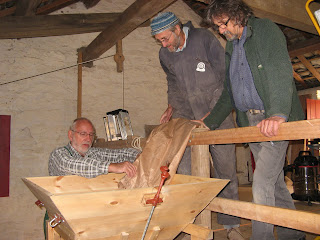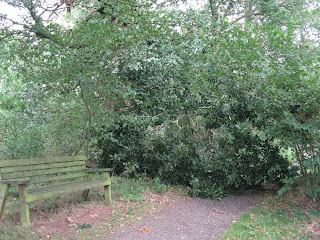So today we set about improving the action of the dump valve. The options were either to make a second board drop, doubling the width of the gap, or to link a vertical board to the dump valve mechanism so that it forms a block across the launder just below the dump valve. Dropping a second board would be a major engineering project, so we concentrated on the second option. The main difficulty was that the available lifting motion from the dump valve mechanism at the point where the new board needs to fit was only about 9cm, and we would need nearer 20cm.
 After exploring many ideas, we concluded that the only way to generate the extra movement is to use a second lever linked to the dump valve actuator with its own separate pivot. We cobbled together an experimental rig using a hoe handle with its pivot in the weatherboard wall of the wheel shed to check the theory and it worked, as the pictures show. Parts of the permanent mechanism will be made over the next few weeks.
After exploring many ideas, we concluded that the only way to generate the extra movement is to use a second lever linked to the dump valve actuator with its own separate pivot. We cobbled together an experimental rig using a hoe handle with its pivot in the weatherboard wall of the wheel shed to check the theory and it worked, as the pictures show. Parts of the permanent mechanism will be made over the next few weeks.
We also noted several issues that may affect the efficiency and power of the waterwheel. Firstly, it leaks badly, and stopping water escaping from the buckets would increase power. Secondly water splashes out of the first bucket due to the height from which it falls from the launder. The side cheeks we noted at New Abbey might help, however we also noted that the end of the launder is not parallel to the axis of the wheel. Finally, as the wheel is pitchback, the water falling from the launder is moving in the opposite direction to the wheel and therefore its horizontal momentum will act as a brake. We began to design a box for the end of the launder to reverse the direction of the final fall of water.











